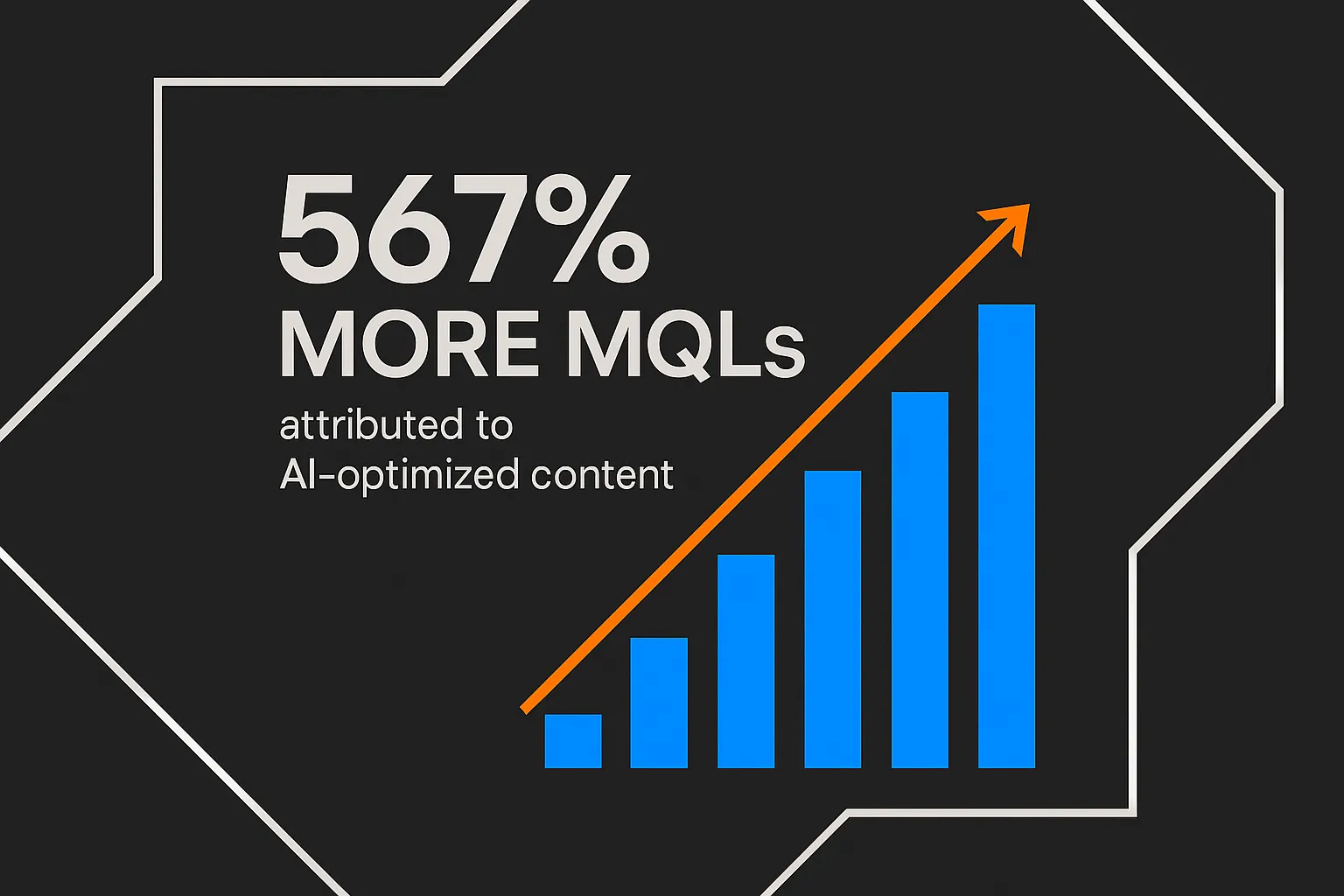Measuring Content ROI in the AI Era: The New Rules for Brand Authority
AI Summary
Measuring Content ROI in the AI Era reveals a new framework for evaluating brand authority beyond traditional metrics. It guides decision-makers through adopting AI-focused KPIs to track influence and impact in generative search environments.
- What:
A modern measurement framework to assess content ROI in AI-driven search by focusing on citations, share of voice, and influence metrics. - Who:
Content marketers and decision-makers seeking to justify their content budget and measure true brand authority. - Why:
Traditional web analytics are inadequate for capturing AI-driven brand influence and authority. - When:
In the current AI search landscape where generative AI responses shape user interactions before website visits. - How:
By integrating advanced tracking tools, focusing on new KPIs like AI citation frequency, share of voice in generative results, and entity association metrics.
You feel it, don't you? The ground is shifting. The old content marketing playbook, the one built on keywords, traffic, and lead-gen forms, feels increasingly inadequate. You're creating content, but proving its real value in a world of AI Overviews and generative search is a challenge. How do you measure the ROI of brand authority when your audience interacts with your ideas before they even visit your website?
Traditional dashboards are failing to capture the full picture. Competitors still publish generic guides on calculating ROI, focusing on funnel metrics that miss the most critical new variable: influence in AI-driven environments. You need a new framework, one that moves beyond simple clicks and conversions to measure what truly matters now. This guide provides that framework. It’s built for decision-makers who need to justify their content budget and future-proof their strategy by proving its impact on the bottom line.
The Shift from Clicks to Citations: Why Your Old ROI Model is Broken
For years, the formula was simple. More traffic meant more leads, and more leads meant more revenue. We built our ROI models on a foundation of web analytics. This included metrics like organic traffic, time on page, bounce rate, and conversion rate. While these numbers still have a place, they are no longer the ultimate arbiters of success.
The rise of AI search changes everything. Generative AI responses and AI Overviews now act as a filter between you and your audience. Your goal is no longer just to rank, but to be cited, referenced, and established as a definitive source within these AI-powered summaries. According to industry analysis, traditional SEO and basic analytics are becoming insufficient for measuring content's true impact on brand authority in these new environments.
Your old model is broken because it cannot measure:
- Influence without a click: When an AI cites your research in an answer, your brand gains authority, even if the user never visits your site.
- Share of voice in generative results: How often does your brand appear as a trusted source in AI-generated responses for your key topics?
- Sentiment and context: How is your brand being portrayed in AI summaries? Is the information accurate and positive?
Continuing to rely solely on website traffic is like trying to navigate a new city with an old map. You can see parts of the landscape, but you're missing the most important new routes to your destination.
The AI-Powered Brand Authority Framework: A New Model for Measuring Content ROI
To succeed, you must adopt a measurement model designed for the AI era. This involves blending traditional performance metrics with a new class of influence-based KPIs. The goal is to create a holistic view of your content's performance, from initial AI impression to final brand conversion. A modern approach demands a technical and analytics stack capable of integrating this data and tracking the user journey seamlessly.
Our AI-Powered Brand Authority Framework provides a clear structure for this new reality. It helps you connect your content efforts directly to business growth by tracking both direct engagement and indirect influence.

This framework isn't about discarding what works. It's about augmenting it. You still need to track lead generation and sales. But you must also account for the powerful, brand-building interactions happening within AI systems.
The Metrics That Matter Now: A Deep Dive into the New KPIs
Let's break down the new metrics that form the core of an AI-first measurement strategy. These KPIs give you the visibility you need to understand and prove your content's authority.
AI Citation Frequency and Quality
This is perhaps the most critical new metric. It tracks how often your brand, content, and experts are cited in AI-generated summaries and responses. According to research from Amsive, effective AI citation tracking involves monitoring not just the frequency but also the accuracy and prominence of your brand's representation.
- What to track: The number of times your domain is sourced in AI Overviews for your target queries.
- How to track it: Use specialized AI search monitoring tools that can analyze SERPs and identify your brand's presence in generative answers.
Share of Voice (SOV) in Generative AI
Traditional SOV measured your visibility in standard search results. The new SOV measures your brand's presence within the content of AI responses. A higher SOV means your brand is dominating the conversation and is perceived as a leading authority by the AI.
- What to track: The percentage of AI-generated answers for a set of keywords that mention or reference your brand.
- How to track it: This requires tools that can scrape and analyze AI responses at scale, comparing your brand's mentions against competitors.
Entity Recognition and Association
Search engines and LLMs understand the world through entities, which are distinct objects like people, places, and brands. Your goal is to have your brand entity strongly associated with your core topics of expertise.
- What to track: The topics and concepts your brand entity is most frequently associated with in AI knowledge graphs.
- How to track it: Tools with entity analysis capabilities can reveal these connections, helping you see if your content is successfully positioning your brand as an expert.
The Ultimate Toolkit for Measuring AI-Driven Content ROI
Tracking these advanced metrics requires a modern toolkit. Relying on Google Analytics alone is no longer sufficient. You need a suite of platforms that work together to provide a complete picture of your content's influence and performance.

- Brand Monitoring Platforms (e.g., Brand24, Mention): These tools are essential for tracking unlinked brand mentions, sentiment, and share of voice across the web, including forums and social media that often feed LLMs.
- AI SEO Platforms (e.g., Authoritas, SEOClarity): Look for platforms that offer specific features for tracking your visibility in AI Overviews and other generative features. They provide the core data for citation frequency and SOV.
- Advanced Attribution Software (e.g., HubSpot, Dreamdata): To connect influence to revenue, you need attribution tools that can track multiple touchpoints across the entire customer journey, linking content consumption to sales outcomes.
- CRM and Analytics Integration: Ensure all your tools feed data into a central system, like your CRM. This allows you to build a comprehensive dashboard that maps influence metrics to hard revenue data, proving the complete ROI story.
Case Study: Proving the Framework's Value
Adopting a modern measurement framework isn't just a theoretical exercise. It delivers tangible business results. One forward-thinking company that shifted its focus from pure volume to strategic authority saw a massive return. By creating high-value, expert-driven content designed to influence both users and AI, they achieved a 567% increase in marketing qualified leads (MQLs).

This success wasn't accidental. It was the result of a deliberate strategy that prioritized creating content with high-ROI formats. Recent research from Penfriend.ai shows that formats like short-form video, AI-enhanced podcasts, and interactive content deliver ROIs as high as 890%. These formats build authority and engage audiences deeply, making them more likely to be recognized and cited by AI systems.
The takeaway is clear. When you measure what matters and create content designed for influence, the return on investment follows.
Building Your Business Case for an AI-First Content Strategy
Armed with this new framework, you can confidently walk into any boardroom and justify your content marketing budget. Instead of presenting vanity metrics, you can show a direct line from content creation to brand authority and, ultimately, to revenue.
This approach transforms content from a cost center into a strategic business asset. However, executing it requires more than just a new dashboard. It demands a system built for this new reality. Implementing a cohesive, AI-driven content plan is complex. It requires deep analysis of your business DNA, competitor vulnerabilities, and strategic content opportunities. This is where an expert SEO Strategist can build the interconnected content architecture needed to dominate in the age of AI.
Your business case should include:
- A clear audit of your current measurement gaps.
- An outline of the AI-Powered Brand Authority Framework.
- Projected improvements in influence metrics like AI citations and SOV.
- A direct connection between these leading indicators and lagging indicators like MQLs and revenue.
Frequently Asked Questions
Is this framework too complex for a small business to implement?
Not at all. The key is to start small. Begin by tracking one or two core AI metrics, such as citation frequency for your top five commercial keywords. You don't need a massive software budget to start. Many tools offer free trials or entry-level plans. The goal is to build the habit of looking beyond traditional analytics, and a focused approach is better than none.
How long does it take to see a return on investment with this new model?
Building true brand authority is a long-term play, but you can see leading indicators change relatively quickly. You might notice an increase in AI citations or brand mentions within the first three to six months of publishing high-quality, authoritative content. The impact on lagging indicators like leads and revenue typically follows as your authority solidifies, often within six to twelve months.
What is the single most important first step I should take?
Your first step is to establish a baseline. Before you change anything, use an AI SEO tool to see where you stand right now. How often are you being cited in AI Overviews for your most important topics? Are you mentioned at all? Understanding your starting point is crucial for measuring progress and proving the value of your future efforts.
The Future of Content ROI is Now
The era of measuring content success with clicks and sessions is over. The future belongs to businesses that understand how to build and measure brand authority in an AI-driven world. By adopting a framework that tracks influence, citations, and share of voice, you move from guessing to knowing. You gain the clarity needed to invest confidently in your content and the data required to prove its undeniable value.
This shift requires more than just new tools. It requires a new way of thinking about your entire business ecosystem. For companies ready to make this leap, a Transformation Strategist can help integrate these principles across your entire operation, building the automated systems that ensure sustainable growth. The new rules are here. It's time to start playing the new game.


